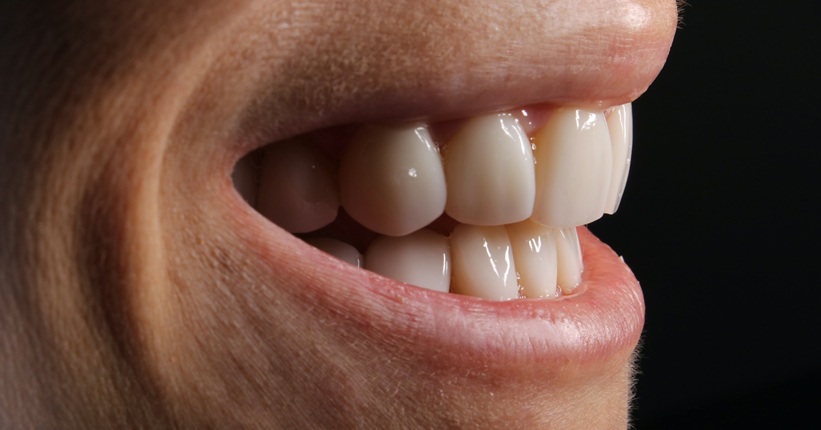
Subosseous dental implants — what are they and when do we recommend them?
Subosseous implants are an innovative solution in modern implantology, created for patients who, due to significant bone loss, are not eligible for treatment with traditional intraosseous implants. Thanks to individual design and the use of advanced digital technologies, subosseous implants allow the restoration of the dentition without the need for a bone transplant, offering efficiency, precision and comfort of treatment even in the most demanding cases. Who can they help? What is the procedure for inserting subosseous implants? What are the benefits of this solution?
What are Subosseous Implants?
Subperiosteal implants are individually designed titanium structures that are placed on the surface of the bone, rather than inside it, as with traditional intraosseous implants. Their main objective is to allow permanent prosthetic work to be embedded in a short time, without the need to carry out complicated and invasive regenerative procedures such as bone grafts. They are attached to the cortical layer of the bone with special screws and then covered with periosteum and gum tissue. Their design requires exceptional precision and individual adjustment to the anatomical shape of the patient's bones. From the structure above the gum protrude one or several fasteners (most often four or six), to which a crown or prosthesis is attached. Thanks to subosseous implants, it is possible to carry out the entire treatment in one surgical phase, which significantly reduces the time of therapy and minimises the patient's discomfort. This method, although known for several decades, has been refined through the use of modern materials and 3D design technologies, which makes it safer and more predictable. It is a particularly valuable alternative for people who, due to bone deficiency, need bone tissue transplantation and thus struggle with a long period of toothlessness and the risk of partial or complete loss of transplanted tissues. Subperiosteal implants avoid these inconveniences by offering patients a more comfortable and less invasive solution.
What is the difference between intraosseous and subosseous implants?
Intraosseous and subosseous implants differ primarily in the place of implantation and indications for use. Intraosseous implants, also called endosteal, are the most commonly used type of dental implants. They are placed directly in the jawbone or mandible, where they integrate into the bone tissue. They are commonly used in patients with an adequate amount of healthy bone.
Subperiosteal implants, on the other hand, are a solution designed for people who have experienced significant bone loss, and it is not possible to use a classic implant without prior bone reconstruction. In this case, the implant is not screwed into the bone but fixed on its surface, under the periosteum, with the help of special fasteners. They provide an opportunity to treat patients who are not eligible for bone grafts or who want to avoid long-term and invasive augmentation procedures.
Advantages of subcostal implants?
Subperiosteal implants are a modern and effective solution for patients who, for various reasons, do not qualify for traditional implant treatment. Their unique design and the way they sit on the bone allow them to bypass many anatomical and health barriers while offering a number of important benefits:
- No need for bone grafting — Subperiosteal implants are placed on the surface of the bone beneath the periosteum, eliminating the need for costly and invasive augmentation procedures in patients with advanced bone loss.
- Shorter healing time — the entire healing process can be much faster than with classic implants, which often require a healing period of several months after a bone transplant.
- Less invasive surgical procedure — the procedure of implantation of subosseous implants is associated with less burden on the patient and a shorter recovery period, which reduces the risk of complications and postoperative discomfort.
- The possibility of treating patients with contraindications to bone grafts is a good option for people who are not eligible for bone reconstruction procedures due to general health, chronic diseases or other contraindications.
- Individual fit to the patient's anatomy — subosseous implants are designed on the basis of three-dimensional images of the bone, which ensures a precise fit, better stabilisation and greater comfort of use of the prosthesis.
- Faster restoration of chewing function — thanks to stable fixation, patients can return to normal eating and daily functioning in less time.
- Improving the aesthetics of the smile and the appearance of the face — a well-fitting prosthesis supported by subosseous implants improves not only the chewing function but also the appearance of the lips and facial contours.
- Lower risk of unsuccessful osseointegration — Subosseous implants do not require adhesion to the bone, which reduces the risk of rejection due to the lack of integration of the implant with the bone tissue.
- Possibility of use in extreme bone atrophy — they are a solution in cases where classical methods of treatment are impossible due to complete bone atrophy.
- Short healing time — a less invasive technique translates into faster tissue healing and fewer restrictions after surgery.
When are subosseous implants recommended?
Indications for the use of subosseous implants:
- Extreme jaw or mandibular bone atrophy — when the amount of bone available is too small to safely insert classic intraosseous implants and bone grafting is not an option or is not advisable.
- Complete or partial toothlessness – especially in patients who have used removable dentures for many years, which led to progressive bone loss and loss of conditions for conventional implantation.
- Atypical anatomical conditions — such as alveolar asymmetry or malformations of the jaw or mandible that prevent standard implant treatment.
- Chronic diseases of the maxillary sinuses — preventing the operation of sinus lift, which is often necessary before implantation of intraosseous implants in the upper dental arch.
- Contraindications to bone grafting — when the patient is not eligible for augmentation procedures due to health conditions, risk of complications or long recovery time.
- The need to shorten the treatment time — subperiosteal implants allow the implantation of prosthetic work immediately after surgery or in a short time, without having to wait long for the adhesion of the transplanted bone.
This method is especially valuable for patients who want to avoid extensive, multi-stage surgical procedures and quickly return to normal functioning with a new dentition.
How are subosseous implants performed?
The process of creating individual subosseous implants is based on advanced digital technologies and modern material engineering. Here are the stages of execution:
Step 1. Scan the patient's bones.
The first step is to make a precise, three-dimensional image of the bone using computed tomography, which allows the anatomical conditions to be assessed without the need to surgically expose the bone.
Step 2. Digital implant design
Based on the image data obtained, an individual model of the implant is created in specialised CAD software, ideally suited to the shape and topography of the patient's bones.
Step 3. Printing Medical Titanium Implant
The finished design goes to a 3D printer, where the implant is built layer by layer from titanium powder, which is melted using a laser working in the infrared. Usually, TiAl6V4 titanium alloy is used, which is distinguished by high strength, resistance to corrosion and cracking, as well as very good biocompatibility with human tissues, which minimises the risk of allergic reactions.
Thanks to this technology, the implant is fully adapted to the patient's anatomy, and the entire process is more predictable, less invasive and faster than traditional methods.
Treatment with subosseous implants step by step
Diagnosis and assessment of the patient's condition
The first step is an accurate diagnosis, which allows you to assess whether the patient is eligible for treatment with subosseous implants. The key study is CBCT (Cone Beam Computed Tomography), which makes it possible to obtain a three-dimensional image of the bone structures of the jaw or lower jaw. Thanks to this, the doctor can accurately assess the quantity and quality of bone tissue, the presence of possible pathological changes, the course of nerves and sinuses, and the degree of bone atrophy. Based on this, a decision is made about further treatment, and the planning of an individual implant begins.
Design and manufacture of an individual implant
Tomography data is sent to specialised 3D CAD software, in which a digital model of the patient's bones is created. On its basis, the subosseous implant is designed so that it fits perfectly to the bone surface and ensures maximum stability. The subcutaneous implant is then 3D printed. Thanks to digital design, it is possible to obtain a highly precise and individually tailored implant without the need for a physical model.
Subperiosteal Implant Implant Procedure
The procedure itself is performed under local or general anaesthesia – depending on the extent of the operation and the patient's preferences. The surgeon makes an incision in the gum and exposes the bone, and a pre-prepared subosseous implant is put on the exposed bone, which is attached to the bone with special screws or hooks. Soft tissues (gums and periosteum) are carefully sutured over the implant, leaving only protruding fasteners for future prosthetic work.
Healing period
After the implantation of the subosseous implant, there is a healing stage, which usually lasts from a few weeks to several months. During this time, the implant integrates mechanically with the surrounding tissues, and the patient wears a temporary prosthesis that allows functioning and does not burden the implant. During the healing period, regular dental check-ups are carried out to monitor the healing process and oral hygiene.
Fixing a fixed prosthesis
When the doctor determines that the subosseous implant and surrounding tissues are completely healed, the final stage of treatment takes place – the implantation of the target prosthetic work. The prosthesis is screwed to the protruding fasteners of the implant and remains permanently in the oral cavity – it does not require removal, which ensures comfort, aesthetics and high functionality.
Content author

Dr. Jan Kempa
Dr. Jan Kempa is a passionate dentist who always cares about a good relationship with patients. His positive attitude makes even the most timid patients feel safe. He specializes in implantology and dental surgery, using modern treatment techniques. He is enthusiastic about using his own tissues to rebuild bones before implantation and to cover gum recession. Dr. Kempa always finds the time to listen to the patient and offers individual solutions.
See also

Start treatment already today!
Make an appointment and discover why our patients recommend us to their loved ones. We will take the utmost care of your smile.


